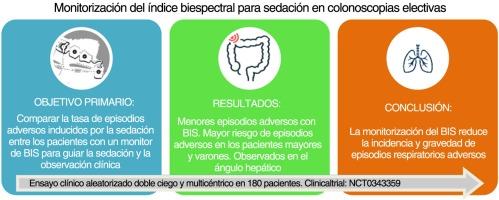Monitorización del índice biespectral para sedación en colonoscopias electivas de pacientes adultos: ensayo controlado aleatorizado
IF 0.9
Q3 ANESTHESIOLOGY
Revista Espanola de Anestesiologia y Reanimacion
Pub Date : 2024-11-01
DOI:10.1016/j.redar.2023.12.003
引用次数: 0
Abstract
Background
Patients should be closely monitored during procedures under sedation outside the operating room, but it is unclear which type of monitoring is best. We investigated the efficacy and safety of BIS monitoring vs conventional monitoring for sedation during colonoscopy.
Methods
We performed a double-blind clinical trial in 180 patients undergoing elective colonoscopy. Patients were randomized to 1) the BIS group or 2) a control group, in which sedation was monitored with a BIS monitor or the Ramsay Sedation Score, respectively. The primary outcome was the rate of sedation-induced adverse events in both groups. Secondary outcomes were the characteristics of patients who developed adverse events, and duration of colonoscopy when these events occurred, propofol and remifentanil dosage, and patient satisfaction.
Results
Univariate analysis showed fewer cardiopulmonary complications in the BIS group (41.11% vs 57.78% in controls; P = .02). Multivariate analysis found a significantly higher risk of adverse events in older patients (95% CI: 1.013-1.091; P = .0087) and in men (95% CI: 1.129-7.668; P = .0272). These events were observed at the hepatic flexure. No significant differences between propofol or remifentanil dosage, use of rescue medication, and patient satisfaction were observed between groups.
Conclusions
Our data suggest that BIS monitoring during sedation in scheduled colonoscopies reduces adverse respiratory events. Although its routine use in sedation does not appear to be warranted, clinicians should take steps to identify patients with a higher risk of complications who might benefit from this type of monitoring.

双频谱指数监测用于成年患者择期结肠镜检查中的镇静剂:随机对照试验
背景在手术室外进行镇静手术时,应对患者进行密切监测,但目前还不清楚哪种监测方式最好。我们研究了 BIS 监测与传统监测在结肠镜检查镇静过程中的有效性和安全性。方法我们对 180 名接受择期结肠镜检查的患者进行了双盲临床试验。患者被随机分为 1) BIS 组或 2) 对照组,对照组分别使用 BIS 监测仪或拉姆塞镇静评分法监测镇静情况。主要结果是两组中镇静引起的不良事件发生率。次要结果是发生不良事件的患者的特征、发生这些事件时结肠镜检查的持续时间、异丙酚和瑞芬太尼的用量以及患者的满意度。结果二元分析显示,BIS 组的心肺并发症较少(41.11% 对对照组的 57.78%;P = 0.02)。多变量分析发现,老年患者(95% CI:1.013-1.091;P = .0087)和男性患者(95% CI:1.129-7.668;P = .0272)发生不良事件的风险明显更高。这些事件都是在肝曲处观察到的。丙泊酚或瑞芬太尼的剂量、抢救药物的使用和患者满意度在组间没有观察到明显差异。虽然在镇静过程中常规使用 BIS 似乎没有必要,但临床医生应采取措施识别并发症风险较高的患者,这些患者可能会从这种监测中获益。
本文章由计算机程序翻译,如有差异,请以英文原文为准。
求助全文
约1分钟内获得全文
求助全文
来源期刊

Revista Espanola de Anestesiologia y Reanimacion
ANESTHESIOLOGY-
CiteScore
1.80
自引率
15.40%
发文量
113
审稿时长
82 days
 求助内容:
求助内容: 应助结果提醒方式:
应助结果提醒方式:


